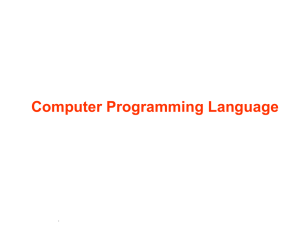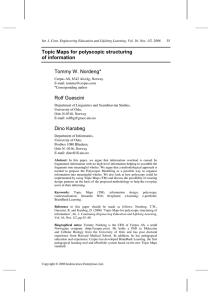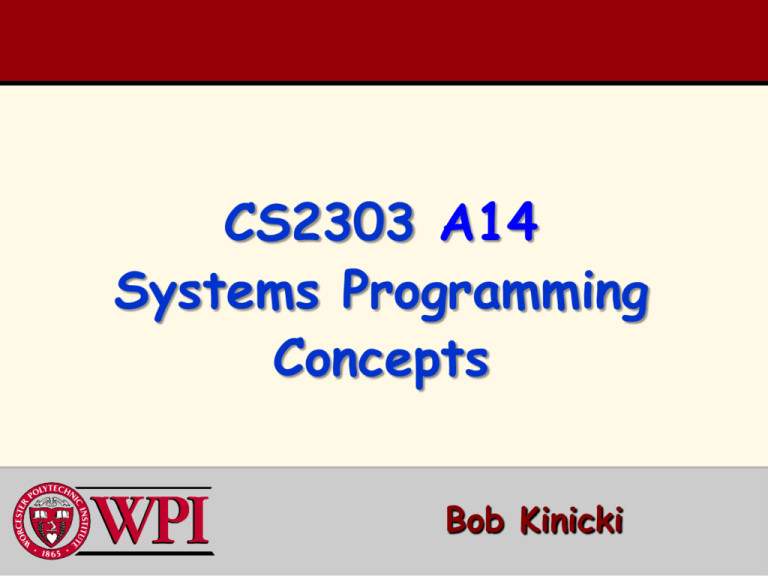
CS2303 A14
Systems Programming
Concepts
Bob Kinicki
Introduction
Systems Programming
Introduction
Survey and TA/SA Introductions
Pause to Look Backwards and Forwards
Course Objectives
Course Operation/Expectations
Course Plan and Syllabus
Systems Concepts
Higher Level Language History
‘Old’ Development Environment
– C and C++
Systems Programming
Introduction
3
Quick Look Backwards/Forwards
Computing Devices
– From mainframes to PCs to
smart phones to ??
Changes in WPI CS Curriculum
Instructor
Students
– Expected Background
– Going Forward
– Your Future
Systems Programming
Introduction
4
CS2303 Course Objectives
To expose students to the low level
systems interface ’grunge’ clearly visible
in C.
To learn to program in C++ by learning
to program in C first.
To further develop the ability to design
programs with emphasis on the abstract
view of data structures.
To get experience with low level
implementation of data structures in C.
Systems Programming
Introduction
5
CS2303 Course Objectives
To learn the advantages of programming
in an object-oriented language such as
C++.
To experience programming in the
Large
Systems Programming
Introduction
6
CS2303 Course Objectives
Pointers!!
Systems Programming
Introduction
7
Course Operation/Expectation
The course web page is an
essential student asset.
*Students are responsible for
ALL information on web pages!
5 Required Labs
5 Programming Assignments
2 Closed Book Exams
Systems Programming
Introduction
8
Course Plan and Syllabus
To cover the details of C briskly.
– Assumes students already have an understanding
of iteration and conditional constructs.
– Using only C I/O {grunge as promised!} at first.
To introduce data structures in C by doing at
least one program with structs and call by
value.
To finish up with as much C++ as possible.
{Note - reading of the textbook will require
jumping around during the C portion of the
course.}
Systems Programming
Introduction
9
Systems Concepts
The goal of this programming course is to
expose the students to places where the
software and hardware meet or where
applications interface with the operating
system (OS).
A systems viewpoint includes resource
management (CPU and memory), process
scheduling, concurrency and performance.
{But this is too much material for this
instance of the course!}
Systems Programming
Introduction
10
Systems Performance Viewpoint
The assignments include simulation and
introduce two system performance
concerns - efficiency and fairness.
The other important approach to
appreciate is the computer scientist
abstraction concept of insulating
interfaces from ‘under-the-hood’
details (e.g., virtual memory and
loaders).
Systems Programming
Introduction
11
1.5 Types of Programming Languages
Although assembly-language code is clearer to humans, it’s
incomprehensible to computers until translated to machine language.
To speed the programming process even further, high-level languages
were developed in which single statements could be written to
accomplish substantial tasks.
High-level languages allow you to write instructions that look almost
like everyday English and contain commonly used mathematical
expressions.
Translator programs called compilers convert high-level language
programs into machine language.
Interpreter programs were developed to execute high-level language
programs directly, although more slowly than compiled programs.
Scripting languages such as JavaScript and PHP are processed by
interpreters.
Copyright © Pearson, Inc. 2013. All Rights Reserved.
Systems Programming
Introduction
12
Higher Level
Programming Languages History
Fortran
Algol
PL1
Pascal
C
Basic
C++
Java
W
W
W
W
W
1957
1960 1968
1964
1970
1972
1975
1986
1995
Systems Programming
COBOL
Lisp
APL
SNOBOL
Prolog
Scheme
ADA
Python
W
W
Introduction
1959
1959
1962
1967
1972
1975
1983
1989
13
C Program Development Environment
Standard Steps
1.
2.
3.
4.
5.
6.
Edit source code
Preprocess
Compile
Link
Load
Execute
Deitel & Deitel
2007 Pearson Ed -All rights reserved.
Fig. 1.1 | Typical C development environment.
Systems Programming
Introduction
14
User Memory Protection
Systems Programming
Introduction
15
Virtual Memory
Systems Programming
Introduction
16
Review of Introduction
Course Objectives
Course Operation/Expectations
Course Plan and Syllabus
C, data structures, C++
Systems Viewpoint {more later}
Program Development Environment
Systems Programming
Introduction
17






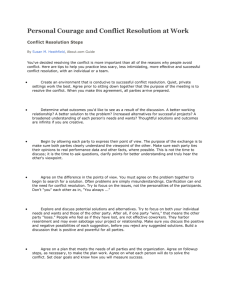
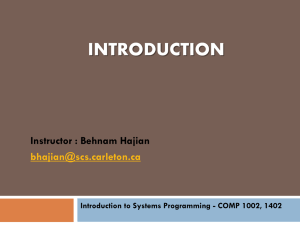
![COURSE NUMBER/TITLE: CS-145 [354-145] COMPUTER SCIENCE II CREDITS:](http://s2.studylib.net/store/data/010725452_1-ae5f1fba080ab698a7d42242aabf0333-300x300.png)
